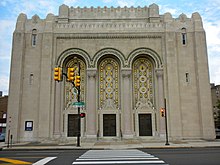Congregation Rodeph Shalom (Philadelphia, Pennsylvania)
| Congregation Rodeph Shalom | |
|---|---|
 |
|
| Basic information | |
| Location | 615 N. Broad Street Philadelphia, Pennsylvania |
| Geographic coordinates | 39°57′55″N 75°9′40″W / 39.96528°N 75.16111°WCoordinates: 39°57′55″N 75°9′40″W / 39.96528°N 75.16111°W |
| Affiliation | Reform Judaism |
| Country | United States of America |
| Status | Active |
| Leadership | Rabbi William I. Kuhn Rabbi Jill Maderer Rabbi Eli C. Freedman Cantor Erin R. Frankel |
| Website | rodephshalom |
| Architectural description | |
| Architect(s) | Simon and Simon |
| Architectural style | Byzantine/Moorish architecture |
| Direction of façade | West |
| U.S. National Historic Landmark | |
| NRHP Reference no. | 07000797 |
| Designated as NHL | August 07, 2007 |
Congregation Rodeph Shalom of Philadelphia, founded in 1795, is the oldest Ashkenazic synagogue in the Western Hemisphere. It is noted historically for its leadership of the Reform Judaism among American Hebrew congregations, for its spiritual influence upon international Jewry, and for its unique 1927 Moorish Revival building on North Broad Street, on the National Register of Historic Places for many decades.
Founded informally as a minyan of ten worshipers in 1795 by Jews from Germany, Holland, and Poland, Rodeph Shalom adopted its first Articles of Association in 1802, and in 1812 was the first synagogue in Pennsylvania to receive a corporate charter. Its records were kept in Yiddish until 1810 and in German until 1830, and it was known mainly as the congregation of recent immigrants until 1840. The congregation differentiated itself from Congregation Mikveh Israel mainly by offering Philadelphia Jews of northern European origin membership at reduced rates and, in cases of hardship, gratis. Welfare provisions were prominent features of Rodeph Shalom's constitution; rabbis were permitted to extend aid of up to five dollars to any sick or poor person, for example. But there was a price for these amenities: absence from Friday evening or Saturday morning services was punishable by fine, excused only by sickness or travel out of town.
Services were held during the congregation's first seven decades in a variety of locations: initially in a building on Margaretta Street before Second; after 1820 at 1 Bread (Moravian) Street; by 1830 at 7 Pear Alley (Chancellor Street); and until 1840 at 15 Vine Street and at Fifth and Cherry. Relatively late in its history, then, the congregation finally built its first building in 1866, a Moorish Revival sanctuary on North Broad Street designed by Philadelphia architect Frank Furness.
...
Wikipedia

